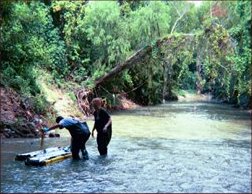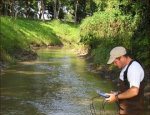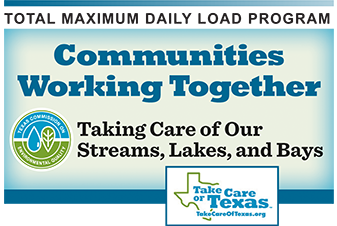Houston-Galveston Region BIG





On This Page:
- Background and Goal
- Status
- Get Involved UPDATE
- Approved I-Plan
- Adopted TMDL
- Reports
- Partners
- Contact the TMDL Program
Watershed Counties: Brazoria, Harris, Fort Bend, Grimes, Liberty, Montgomery, San Jacinto, Walker, and Waller
Parameter: Bacteria
Basin: San Jacinto, San Jacinto–Brazos Coastal
Background and Goal
Water quality testing found that bacteria concentrations are elevated in numerous waterways in the Houston–Galveston region. High bacteria concentrations might pose a risk to people who swim or wade in natural waters. Swimming and wading are called “contact recreation” in the state’s standards for water quality; the term refers to all recreation in which people are likely to swallow natural waters.
The goal of this project is to reduce bacteria concentrations and protect recreational safety. This project included 72 TMDLs for 60 waterway segments. This area covers approximately 3,260 square miles across 10 counties and 63 cities, including much of the city of Houston. The area has a population of nearly five million people. Several TMDLs and segments have been added since the I-Plan was completed.
Status
The commission approved the stakeholder-developed I-Plan on Jan. 30, 2013. This I-Plan was developed by stakeholders in the Bacteria Implementation Group (BIG) .
Watch the BIG video on YouTube. The BIG is a diverse group of committed and concerned people, representing a cross-section of concerned citizens from many disciplines. The group works for better quality water in the area covered by their plan.
Annual Reports of Implementation Progress
In mid-2020, the BIG published its most recent Annual Report of progress in reducing bacteria in Houston–Galveston area waterways. Download the latest BIG Annual Reports at the H-GAC's BIG website. See also the Map-based Interactive Progress Report .
An annual report was presented at the Fall Meeting on Oct. 29, 2024. Read about the most recent updates presented in this meeting on the H-GAC website .
Activities
The I-Plan identifies eleven primary strategies for achieving environmental goals. These strategies relate to:
- wastewater treatment facilities
- on-site sewage facilities
- sanitary sewer systems
- stormwater and land development
- construction
- illicit discharges and dumping
- agriculture and animals
- residential areas
- monitoring progress and updating the plan
- research
- a geographic priority framework
The I-Plan outlines numerous activities under each of these strategies. Read the I-Plan.
Get Involved NEW
The Bacteria Implementation Group (BIG) is coordinating public participation in improving Houston-area waterways. Meetings of the BIG are open to everyone. Meeting records are available on the BIG’s website. Find out more about what it means to Participate in TMDL Projects.
H-GAC Bacteria Implementation Group Fall Meeting 2025
At this stakeholder meeting, we will discuss the Bacteria Reduction Implementation Plan update, 2025 Annual Report, and new methods in bacteria source tracking. This meeting will be virtual and in-person.
- https://www.tceq.texas.gov/waterquality/tmdl/nav/42-houstonbacteria/h-gac-bacteria-implementation-group-fall-meeting-2025
- H-GAC Bacteria Implementation Group Fall Meeting 2025
- 2025-10-28T13:00:00-05:00
- 2025-10-28T15:00:00-05:00
- At this stakeholder meeting will discuss the Bacteria Reduction Implementation Plan update, 2025 Annual Report, and new methods in bacteria source tracking. This meeting will be virtual and in-person.
Oct 28, 2025 from 01:00 PM to 03:00 PM (America/Chicago / UTC-500)
Houston Galveston Area Council
Conference Rooms B&C
3555 Timmons Lane, Houston, 77027
Harris County
Partners
San Jacinto River Authority
Houston-Galveston Area Council
Texas State Soil and Water Conservation Board
Texas Commission on Environmental Quality
Harris County
Montgomery County
Harris County Flood Control District
Harris County Soil & Water Conservation District #442
Buffalo Bayou Partnership
City of Conroe
City of Houston
City of League City
City of Webster
Cypress Creek Flood Control Coalition
Nottingham Country
Municipal Utility District
Gulf Coast Waste Disposal Authority
Bayou Preservation Association
Galveston Bay Foundation
Greater Houston Partnership
Houston Audubon Society
Dodson & Associates, Inc./HCEC
Pate Engineers
The Woodlands Joint Powers Agency
AECOM
Schwartz, Page, & Harding, LLP
LDP Consultants Inc.
Texas Coastal Partners
Lone Star College
US Geological Survey
Approved I-Plan
The commission approved the I-Plan on Jan. 30, 2013. This plan was developed by stakeholders in the Bacteria Implementation Group (BIG)
This plan originally implemented 72 TMDLs for 60 waterway segments in 10 counties. Other TMDLs and water bodies have since been added. The TMDLs for Armand Bayou were added to the BIG I-Plan by vote of the BIG and the Armand Bayou stakeholders in 2014; the commission approved this action in 2015. The TMDLs for San Jacinto River were added by vote of the BIG and the San Jacinto stakeholders in 2015; the commission approved this action in 2016. The TMDL for Jarbo Bayou was added to the BIG I-Plan by vote of the BIG and the Jarbo Bayou stakeholders in 2015; the commission approved this action in 2018. Several TMDLs have also been added by addenda to the original TMDLs.
Adopted TMDL
On the date of their approval by EPA, all these TMDLs became part of the state’s Water Quality Management Plan.
- Armand Bayou: The commission adopted these TMDLs on Aug. 5, 2015. The EPA approved them on Oct. 2, 2015. The EPA approved Addendum I to the TMDLs on Feb. 22, 2019.
- Brays Bayou watersheds: The commission adopted these TMDLs on Sept. 15, 2010. The EPA approved them on Sept. 27, 2010. The EPA approved an addendum to the TMDLs in August 2013.
- Buffalo and Whiteoak Bayous: The commission adopted these TMDLs on April 8, 2009. The EPA approved them on June 11, 2009. The EPA approved Addendum I to the TMDLs in August 2013. The EPA approved Addendum II to the TMDLs in July 2015.
- Clear Creek: The commission adopted these TMDLs on Sept. 10, 2008. The EPA approved them on March 6, 2009. The EPA approved an Addendum I to the TMDLs in March 2013. The EPA approved Addendum II to the TMDLs on Feb. 22, 2019.
- Eastern Houston watersheds: The commission adopted these TMDLs on Sept. 15, 2010. The EPA approved them on Sept. 27, 2010. The EPA approved Addendum I to the TMDLs in Aug. 2013. The EPA approved Addendum II to these TMDLs on Feb. 22, 2019.
- Greens Bayou: The commission adopted these TMDLs on June 2, 2010. The EPA approved them on Aug. 12, 2010.
- Halls Bayou: The commission adopted these TMDLs on Sept. 15, 2010. The EPA approved them on Sept. 27, 2010.
- Jarbo Bayou: The commission adopted this TMDL on Jan. 24, 2018. The EPA approved the TMDL on March 29, 2018.
- Lake Houston Upstream Watersheds: The commission adopted these TMDLs on April 6, 2011. The EPA approved them on June 29, 2011. The EPA approved an addendum to the TMDLs in Feb. 2014.
- San Jacinto River, East and West Forks; Lake Houston; and Crystal Creek: The commission adopted these TMDLs on Aug. 24, 2016. The EPA approved them on Oct. 7, 2016. The EPA approved Addendum I to the TMDLs on Feb. 22, 2019.
- Sims Bayou: The commission adopted these TMDLs on Sept. 15, 2010. The EPA approved them on Sept. 27, 2010. The EPA approved an addendum to the TMDLs in Aug. 2013.
Revisions to TMDLs
From time to time, it is necessary to revise TMDLs to account for changing conditions in the watershed. Revisions to the load allocations in TMDLs are made via the state’s Water Quality Management Plan (WQMP), which is updated quarterly.
The WQMP provides projected effluent limits for use in planning and permitting activities under the Texas Pollutant Discharge Elimination System (TPDES). The TCEQ reviews all applications for new and amended permits for conformance with applicable portions of the WQMP, including adopted TMDLs.
Revisions are made to TMDLs in one of two ways:
- Updates are made to account for changing conditions in the watershed, such as new or revised wasteload allocations, permits that have been canceled or have expired, or changed facility names.
- Addendums are created to add load allocations for assessment units that are impaired by the same pollutant or condition, within the same watershed as in the original TMDL report.
Revisions to the TMDLs are documented next to the original TMDL report in the table below. Both updates and addendums are provided in the same units of measure used in the original TMDL.
WQMP updates may be viewed in person at the TCEQ Library, Building A, 12100 Park 35 Circle, Austin, Texas. Electronic versions of updates published from 2014 through the present are available on the Texas State Library and Archives Commission website .
For WQMP updates prior to 2014, use the TRAIL Search engine as outlined below. The main search box on the page will only conduct a simple search with no exclusionary parameters and should not be used.
- First, limit your search to TCEQ only. Do this via the advanced search feature on the left of the page. To limit a search to TCEQ content, enter "www.tceq.texas.gov" or "www.tceq.state.tx.us" into the “From the Host” search box.
- Refine your search to narrow down results. The other search boxes on the left of the page allow for search terms to be included, excluded, or used in an exact phrase search. Date ranges can be used as well.
All linked files in the table below are provided in PDF
|
TMDLs |
Addenda |
Updates |
|---|---|---|
|
Armand Bayou
Six TMDLs for Indicator Bacteria in Armand Bayou |
TMDL Addendum I: One TMDL for Indicator Bacteria in Armand Bayou |
|
|
Brays Bayou
Five TMDLs for Indicator Bacteria in Brays Bayou Above Tidal and Tributaries |
TMDL Addendum I: Three TMDLs for Brays Bayou Watershed
TMDL Addendum II: One TMDL for Harris County Flood Control Ditch D 138 |
April 2022, Appendix I, p18-19 |
|
Buffalo and Whiteoak Bayous
Eighteen TMDLs for Bacteria in Buffalo and Whiteoak Bayous and Tributaries Response to Public Comment on the Buffalo and Whiteoak Bayous TMDLs |
TMDL Addendum I: One TMDL for Bacteria in Vogel Creek
TMDL Addendum II: One TMDL for Bacteria in Rolling Fork Creek
TMDL Addendum III: One TMDL for Bacteria in Horsepen Creek |
July 2022, Appendix I, p 17-18 |
|
Clear Creek
Nine TMDLs for Bacteria in Clear Creek and Tributaries |
TMDL Addendum I: Four TMDLs for Indicator Bacteria in Clear Creek Watershed
TMDL Addendum II: One TMDL for Indicator Bacteria in Mary's Creek Bypass |
January 2022, Appendix III, p 15-16 |
|
Eastern Houston Watersheds
Thirteen TMDLs for Indicator Bacteria in Eastern Houston Watersheds Response to Public Comment on the Eastern Houston Watersheds TMDLs |
TMDL Addendum I: One TMDL for Eastern Houston Watersheds |
January 2016, Appendix V, p 16 |
|
Greens Bayou
Eight TMDLs for Indicator Bacteria in Greens Bayou Above Tidal and Tributaries |
|
January 2022, Appendix IV, p 17-18 |
|
Halls Bayou and Tributaries
Four TMDLs for Indicator Bacteria in Halls Bayou and Tributaries |
July 2022, Appendix II, p 19-20 |
|
|
Jarbo Bayou
One TMDL for Indicator Bacteria in Jarbo Bayou |
Addendum I: One TMDL for Indicator Bacteria in Jarbo Bayou Segment: 2425B |
|
|
Lake Houston Upstream Watersheds
Fifteen TMDLs for Indicator Bacteria in Watersheds Upstream of Lake Houston Response to Public Comment on the Lake Houston Upstream Watersheds TMDLs |
TMDL Addendum I: Six TMDLs for Lake Houston Area Watersheds
TMDL Addendum II: Two TMDLs for Brushy Creek and Spring Branch
TMDL Addendum III: One TMDL for Walnut Creek
TMDL Addendum IV: One TMDL for Caney Creek |
July 2022, Appendix III, p 21-25 |
|
San Jacinto River, East and West Forks; Lake Houston; and Crystal Creek
Seven TMDLs for Indicator Bacteria in the East and West Forks of the San Jacinto River, Lake Houston, and Crystal Creek Watersheds Response to Public Comment on the East and West Fork San Jacinto River TMDLs |
TMDL Addendum I: One TMDL for Indicator Bacteria in Mound Creek
TMDL Addendum II: One TMDL for Indicator Bacteria in White Oak Creek
TMDL Addendum III: One TMDL for Indicator Bacteria in Winters Bayou |
April 2022, Appendix III, p 22-25 |
|
Sims Bayous and Tributary
Four TMDLs for Indicator Bacteria in Sims Bayou Above Tidal and Tributary |
TMDL Addendum I: One TMDL for Sims Bayou Watershed |
April 2018, Appendix IV, p 17-18 |
Reports and Other Documents
Armand Bayou Reports
-
Technical Support Document, August 2018
Segment 1113 -
Technical Support Document, April 2014
Segments 1113, 1113A, 1113B, 1113C, 1113D, and 1113E
Buffalo and Whiteoak Bayous Reports
- Technical Support Document for Horsepen Creek, Addendum III (AU 1014C_01)
- Technical Support Document for Rolling Fork Creek, Addendum II (Segment 1017F)
-
Technical Support for Additional TMDL Segments in the Houston Metropolitan Area
Includes Vogel Creek, Segment 1017C, approved as Addendum I to the Buffalo Bayou TMDLs - Appendix A
- Appendix B
- Appendix C
- Appendix D
- Appendix E
- TMDL Technical Support Document, June 2008
- Appendixes, June 2008
Clear Creek Watershed Reports
- Technical Support for Bacteria TMDL for Mary's Creek Bypass, Clear Creek Watershed, Addendum II
- Technical Support for Bacteria TMDLs, Clear Creek Watershed, Addendum I (15 MB)
- Appendix A
- Appendix B
- Appendix C
- Appendix D
- Appendix E
- Appendix F
- Appendix G
- Appendix H
- Appendix I
- Appendix J
- Appendix K
- 2008 Technical Support for Bacteria TMDLs, Clear Creek Watershed
- 2005 Final Report: Clear Creek Watershed
- Appendix A
- Appendix B
- Appendix C
- Appendix D
- Appendix E
- Appendix F
- Appendix G
- Appendix H
- Appendix I
Brays, Greens, Halls, and Sims Bayous and Eastern Houston Watersheds Reports
- Technical Support Document for One TMDL for Indicator Bacteria for Harris County Flood Control Ditch D 138
- Technical Support for Additional TMDL Segments in the Houston Metropolitan Area
- Appendix A
- Appendix B
- Appendix C
- Appendix D
- Appendix E
- Greens Bayou Final Report
- Brays Bayou Final Report
- Halls Bayou Final Report
- Sims Bayou Final Report
- Eastern Houston Bayous Final Report
Jarbo Bayou Reports
Lake Houston Upstream Watershed Reports
- Technical Support Document for One TMDL for Indicator Bacteria in Caney Creek Assessment Unit 1010_03, Addendum IV May 2022
- Technical Support Document for One TMDL for Indicator Bacteria for Walnut Creek, Assessment Unit: 1008I_01, Addendum III, August 2020
- Technical Support Document for Brushy Creek and Spring Branch, Addendum II, July 2019
- Technical Support Document for Upper and Lower Panther Branch, Bear Branch, and Peach Creek, Addendum I, June 2013
- Technical Support Document for Lake Houston Upstream Watersheds September 2009
- Monitoring Results - October 2008 (16.7 MB)
- Synoptic Sampling Survey Results - Collected November 2007
- Monitoring Plan
- Preliminary Data Review
San Jacinto River, East and West Forks; Lake Houston; and Crystal Creek Watersheds Reports
- Technical Support Document for One TMDL for Bacteria in White Oak Creek
- Technical Support Document for Bacteria TMDL for Mound Creek, Addendum I
- 2015 Technical Support Document for East and West Forks San Jacinto River, Lake Houston, and Crystal Creek Watersheds
Contact the TMDL Program
Please contact Steven Johnston, the Project Manager at the H-GAC, at 713-627-3200 or email Steven Johnston. You may also e-mail tmdl@tceq.texas.gov and mention the Houston-Galveston bacteria project in the subject line. Reach the TMDL Program by phone at 512-239-6682.




 Back to top
Back to top